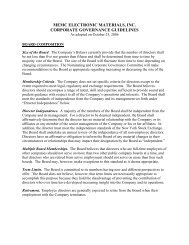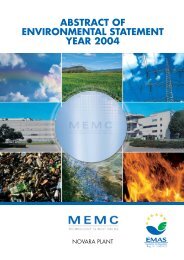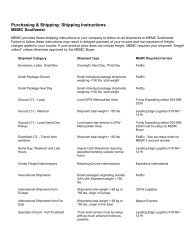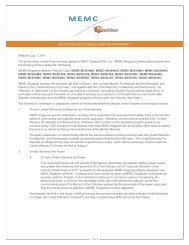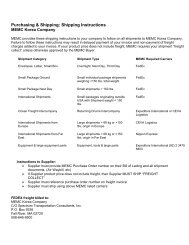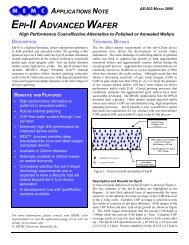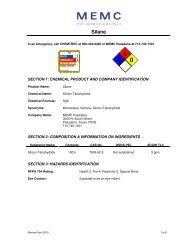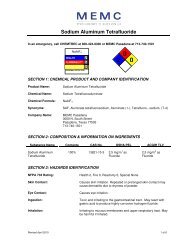MEMC Glossary - MEMC Electronic Materials, Inc.
MEMC Glossary - MEMC Electronic Materials, Inc.
MEMC Glossary - MEMC Electronic Materials, Inc.
Create successful ePaper yourself
Turn your PDF publications into a flip-book with our unique Google optimized e-Paper software.
Cubic Feet per Minute (CFM): Volumetric flow rate used to meter gases.CVD (Chemical Vapor Deposition): Formation of a solid film on a substrate through the reaction of gas-phase reactants (precursors)that contain the required constituents.Czochralski (CZ): Crystal growing process that was named after the inventor.DDefect Free Region: The linear distance from the frontside wafer surface to the depth of the first bulk defect.Degree: Unit of measuring angles when orienting an ingot.Design of Experiments (DOE): Method to design, run and analyze an experiment to maximize information and minimize testing.Diameter: Straight-line measurement drawn through the center of a circle or sphere from one side to the other.Diffusion: A method of doping or modifying the characteristics of semiconductor material by "baking" wafers of the basesemiconductor material in furnaces with controlled atmospheres of impurity materials.Diffusion Length: The distance a front side free-electron or hole can travel through a crystal. This is proportional to the Lifetime ofthe crystal.Dislocation: A class of one-dimensional, or line defects in silicon crystals.DNZ (Denuded Zone Depth): The linear distance from the frontside wafer surface to the depth where the defect density appearsnearly uniform.Donor: Atom, usually an impurity in silicon, that acts as an electron source. It contributes an extra electron to the crystal structure.Most common is phosphorus.Dopant: Element added to silicon decreasing its resistivity. Silicon, by itself does not conduct electricity. Boron is usually used for p-type and phosphorus is usually used for n-type.Doping or Dopant: Chemical impurities added to polysilicon which will yield either n- or p-type silicon, depending on the specificdopant used.EEdge Crown: The difference between the surface elevation 1/8" (3.2mm) from the edge of the slice and the elevation of the sliceedges exposed in microns (associated with epi layer deposition).Edge Exclusion: Narrow band on the outside edge of the wafer that does not have an oxide coating.Edge Grinding: Process that bevels the edges of the slices to strengthen them.Ellipsometer: Optical measuring device used to measure oxide and nitride thickness, as well as, the index of refraction.Epi: (epitaxial or epitaxy process) Depositing a thin layer of silicon atoms onto a wafer by condensing a controlled amount of silicongas (silane) onto the polished surface of the wafer in a temperature-controlled environment.Epitaxial Layer: The layer or layers of semiconductor material having the same crystalline orientation as the host substrate on whichit is grown.Endcone or Bottom: Gradual decreases in diameter until the silicon forms a point at the end of the growing/pulling process. As a ruleof thumb, the bottom/endcone should be grown the length of the rod’s diameter to allow for shock back or undesirable structure.Etch: To remove or dissolve surface contamination, work-damaged material (polishing), and to control thickness by chemical actionwith strong acid and alkaline compounds.Etch – Mirror: Used to create a clean, shiny finish for visual inspection and resistivity measurements.Etch – Preferential: An etch that exhibits an accelerated etch rate along specific crystallographic planes.Etch Rate: Rate of silicon removal in microns per minute.



